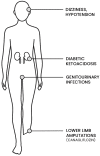SGLT2 Inhibitors in Type 2 Diabetes Mellitus and Heart Failure-A Concise Review
- PMID: 35329796
- PMCID: PMC8952302
- DOI: 10.3390/jcm11061470
SGLT2 Inhibitors in Type 2 Diabetes Mellitus and Heart Failure-A Concise Review
Abstract
The incidence of both diabetes mellitus type 2 and heart failure is rapidly growing, and the diseases often coexist. Sodium-glucose co-transporter 2 inhibitors (SGLT2i) are a new antidiabetic drug class that mediates epithelial glucose transport at the renal proximal tubules, inhibiting glucose absorption-resulting in glycosuria-and therefore improving glycemic control. Recent trials have proven that SGLT2i also improve cardiovascular and renal outcomes, including reduced cardiovascular mortality and fewer hospitalizations for heart failure. Reduced preload and afterload, improved vascular function, and changes in tissue sodium and calcium handling may also play a role. The expected paradigm shift in treatment strategies was reflected in the most recent 2021 guidelines published by the European Society of Cardiology, recommending dapagliflozin and empagliflozin as first-line treatment for heart failure patients with reduced ejection fraction. Moreover, the recent results of the EMPEROR-Preserved trial regarding empagliflozin give us hope that there is finally an effective treatment for patients with heart failure with preserved ejection fraction. This review aims to assess the efficacy and safety of these new anti-glycemic oral agents in the management of diabetic and heart failure patients.
Keywords: diabetes mellitus type 2; heart failure; sodium-glucose co-transporter 2; sodium-glucose co-transporter 2 inhibitors.
Conflict of interest statement
The authors declare no conflict of interest.
Figures




Similar articles
-
Emerging concepts in heart failure management and treatment: focus on SGLT2 inhibitors in heart failure with preserved ejection fraction.Drugs Context. 2023 Jan 4;12:2022-7-1. doi: 10.7573/dic.2022-7-1. eCollection 2023. Drugs Context. 2023. PMID: 36660013 Free PMC article. Review.
-
Evaluation of the effect of sodium-glucose co-transporter 2 inhibition with empagliflozin on morbidity and mortality of patients with chronic heart failure and a reduced ejection fraction: rationale for and design of the EMPEROR-Reduced trial.Eur J Heart Fail. 2019 Oct;21(10):1270-1278. doi: 10.1002/ejhf.1536. Epub 2019 Jul 16. Eur J Heart Fail. 2019. PMID: 31584231
-
SGLT2 inhibitors in patients with heart failure with reduced ejection fraction: a meta-analysis of the EMPEROR-Reduced and DAPA-HF trials.Lancet. 2020 Sep 19;396(10254):819-829. doi: 10.1016/S0140-6736(20)31824-9. Epub 2020 Aug 30. Lancet. 2020. PMID: 32877652
-
Sodium-glucose co-transporter 2 inhibitors in heart failure: beyond glycaemic control. A position paper of the Heart Failure Association of the European Society of Cardiology.Eur J Heart Fail. 2020 Sep;22(9):1495-1503. doi: 10.1002/ejhf.1954. Epub 2020 Aug 5. Eur J Heart Fail. 2020. PMID: 32618086
-
Update on the Cardiovascular Benefits of Sodium-Glucose Co-Transporter-2 Inhibitors: Mechanism of Action, Available Agents and Comprehensive Review of Literature.Cardiol Res. 2021 Aug;12(4):210-218. doi: 10.14740/cr1268. Epub 2021 Jun 5. Cardiol Res. 2021. PMID: 34349861 Free PMC article. Review.
Cited by
-
Non-coding RNAs in diabetes mellitus and diabetic cardiovascular disease.Front Endocrinol (Lausanne). 2022 Sep 6;13:961802. doi: 10.3389/fendo.2022.961802. eCollection 2022. Front Endocrinol (Lausanne). 2022. PMID: 36147580 Free PMC article. Review.
-
Decongestion in Acute Heart Failure-Time to Rethink and Standardize Current Clinical Practice?J Clin Med. 2024 Jan 5;13(2):311. doi: 10.3390/jcm13020311. J Clin Med. 2024. PMID: 38256444 Free PMC article. Review.
-
Impact of Sodium-Glucose Cotransporter 2 Inhibitors on Cardiovascular and Renal Outcomes in Heart Failure Patients With Type 2 Diabetes: A Literature Review.J Clin Med Res. 2024 Sep;16(9):398-410. doi: 10.14740/jocmr5230. Epub 2024 Sep 4. J Clin Med Res. 2024. PMID: 39346567 Free PMC article. Review.
-
mTORC1 and SGLT2 Inhibitors-A Therapeutic Perspective for Diabetic Cardiomyopathy.Int J Mol Sci. 2023 Oct 11;24(20):15078. doi: 10.3390/ijms242015078. Int J Mol Sci. 2023. PMID: 37894760 Free PMC article. Review.
-
The Renoprotective Mechanisms of Sodium-Glucose Cotransporter-2 Inhibitors (SGLT2i)-A Narrative Review.Int J Mol Sci. 2024 Jun 27;25(13):7057. doi: 10.3390/ijms25137057. Int J Mol Sci. 2024. PMID: 39000165 Free PMC article. Review.
References
-
- Ogurtsova K., da Rocha Fernandes J.D., Huang Y., Linnenkamp U., Guariguata L., Cho N.H., Cavan D., Shaw J.E., Makaroff L.E. IDF Diabetes Atlas: Global Estimates for the Prevalence of Diabetes for 2015 and 2040. Diabetes Res. Clin. Pract. 2017;128:40–50. doi: 10.1016/j.diabres.2017.03.024. - DOI - PubMed
-
- Gerstein H.C. The Hemoglobin A1c Level as a Progressive Risk Factor for Cardiovascular Death, Hospitalization for Heart Failure, or Death in Patients with Chronic Heart Failure: An Analysis of the Candesartan in Heart Failure: Assessment of Reduction in Mortality and Morbidity (CHARM) Program. Arch. Intern. Med. 2008;168:1699. doi: 10.1001/archinte.168.15.1699. - DOI - PubMed
Publication types
LinkOut - more resources
Full Text Sources

